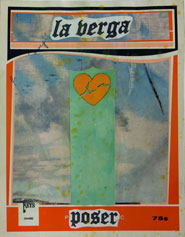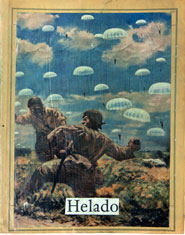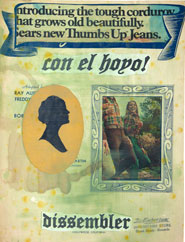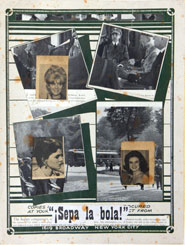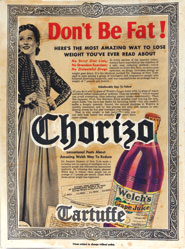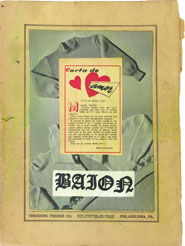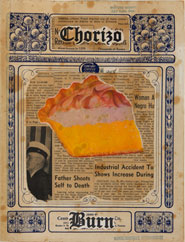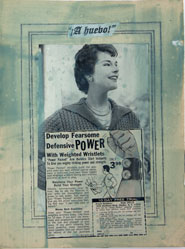| |
In an effort to explain this body of work I will put down the thoughts that passed through my mind as I created the work, “Selections from the Great Mexican-American Songbook”. The work has to do with my childhood and language. I grew up in a bicultural family, Anglo/white on my mother’s side and Mexican on my father’s side and I felt that I never fit in. I was either Mexican or white depending on what side of my family I was spending time with. Language to me is the fact that, Spanish is the language of secrets; Spanish was spoken in front of me to keep me from knowing something. Spanish was never spoken in my home and when I was a child English was rarely spoken with my father’s family.
In the concept behind the series, this artwork has very little to do with “music”, but it does have to do with images and language, “the language of images”, if you will. I chose to do the work with/on sheet music, because years ago I acquired a stack of sheet music and figured eventually I could do something with it. I kept this stack around for about a decade as raw material until one day I went through them and found several bound volumes of music in the pile called “The Great American Songbook” or “American Songbook” I looked up on the internet the concept of the “American Songbook” and came across the Wikipedia entry “There is no consensus on which songs are in the "Great American Songbook Music critics have attempted to develop a "canon." From some perspectives, the Songbook era ended with the advent of rock and roll”
So I figured that I could use this idea of an undefined list of music and create a “Mexican-American Songbook”. And since this era ended around the 1950s I could refer back to a 1940s, 50s and 60s aesthetic or historical period. I wanted to include the presence of LATINOS, MEXICANS in American history. This is in response to a paper installation on memories of my maternal (Anglo/white) grandfather who served in WWII in the navy. He worked as a machinist at shipyards in California and never went to sea. The exhibition was about loss and regret and disappointment. It dawned on me that my paternal (Mexican) grandfather also served in WWII in the Army and he possibly, more than likely, saw combat but no one ever talked about it. He could not or would not attend any fireworks display because he would get distressed, BUT NO ONE EVER TALKED ABOUT IT!
I wanted to capture the feeling I had as a child. As a child everything had the same type of meaning, something was not more important than the other. I had not developed a hierarchy of importance, for example if my parents were voting for McGovern or Nixon was the same meaning or importance to me as was playing with my G.I. Joes or wanting a bike or having to take a bath. Everything was the same when I was as a child. Compound this with having to spend time with a half of my family that I was not able to communicate with. Magazines were very important to me as a child; it seemed that everyone had some kind of magazines old and/or new “TV Guide”, “Prevention”, “Time”, “Life”, “National Geographic”, “Look”, which they would give to me and for me to be quite. I would look though these magazines wherever I went, and I would encounter a parallel world of Spanish language magazines at my father’s family’s home!
As a child I really was just looking at the pictures in both the Spanish and English magazines, I really did not understand what was going on in most of them until I got older. The same thing was happening with television or radio, but magazines seemed more prevalent because when visiting the TV and radio was turned off. Of course there is Socio-political content to the work, this is true in all artwork, but it changes from viewer to viewer. Marxists will see the work differently than right-wingers and I want different people to see and feel different things when they view the same work. I really think that my artwork should function without knowing what was going on in my mind when I was making it.
|
|
Paul Valadez |



